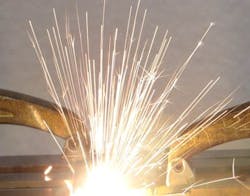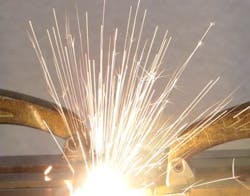A 10-partner project dubbed Laser Welding of Steel to Aluminum for Applications in Shipbuilding (LaSAAS), led by Laser Zentrum Hannover eV (LZH; Hannover, Germany), is working to develop a robust laser welding process for maritime manufacturing.
In times of scarce resources, it is also important in the ship industry to lower fuel consumption and carbon dioxide output to reduce environmental impact. Already, components are being made using weight-reducing steel-aluminum constructions, such as ship hulls made of steel and superstructures made of aluminum. In addition, such hybrid material constructions lower the center of gravity of the ship and thus stabilize it. At the moment, the different metals are joined using an adapter piece. This is done using explosive cladding, a complicated and cost-intensive joining technology.
Scientists and industrial partners involved in the LaSAAS project want to replace this adapter piece. For this purpose, system manufacturers Precitec (Gaggenau, Germany), Scansonic MI (Berlin, Germany), and TRUMPF (Ditzingen, Germany) are working together with LZH to develop a laser processing head with weld penetration depth control.
Using this, LZH will develop a laser welding process under lab conditions that will later be tested in cooperation with LASER on demand (Langenhagen, Germany). Afterwards, the process will be transferred to actual applications by semi-finished product manufacturers Druckguss Service Deutschland (Lübeck, Germany) and Hilbig (Seevetal, Germany) as well as the Fr. Lürssen Werft (Bremen, Germany) and Meyer Werft (Papenburg, Germany) shipyards. Also, the Fraunhofer Institute for Structural Durability and System Reliability (LBF; Darmstadt, Germany) will examine the fatigue behavior of the seams, especially under the influence of corrosive media.
When thermally welding steel to aluminum, brittle intermetallic phases occur, which makes the seams prematurely fail under stress. However, weld seam characteristics can be optimized based on the mix ratio of the metals, with respect to the weld penetration depth. So, the project partners plan to control weld penetration depth by analyzing the spectral process emissions and short coherence interferometry.
If successful, the process could show promise for interesting for other industries that assemble large pieces, such as train coach or commercial vehicle construction.
For more information, please visit www.lzh.de/en.

